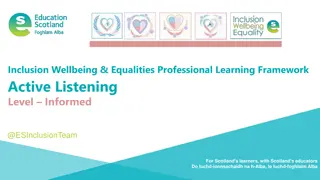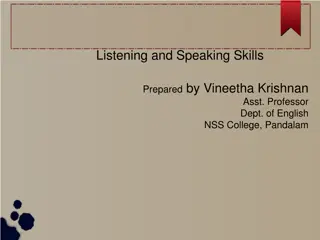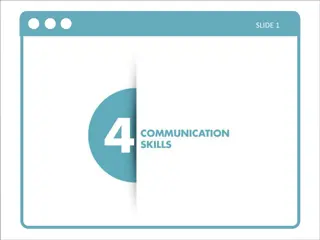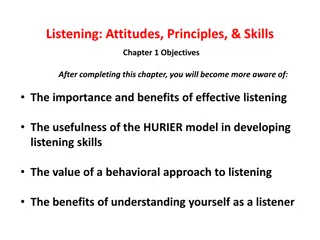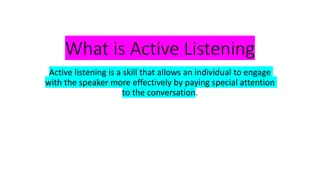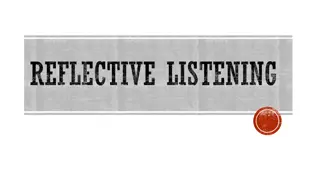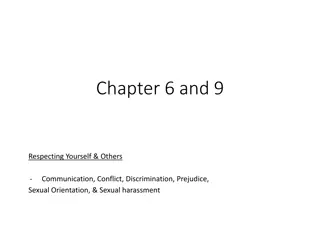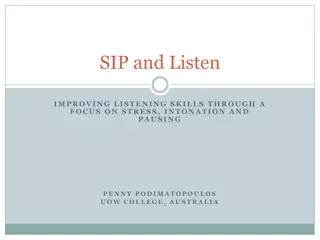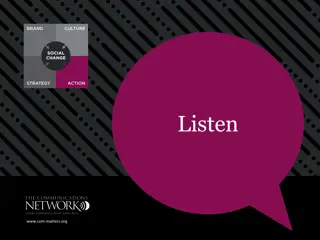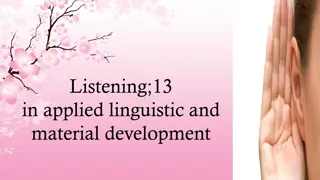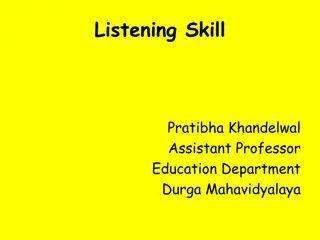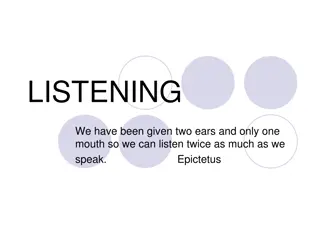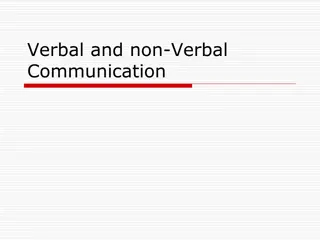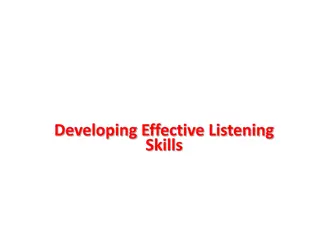Understanding the Art of Communication and Listening
Communication is a dynamic process of transmitting information, ideas, and attitudes among individuals. It involves various stimuli such as hearing, smell, seeing, touch, and taste. Effective communication requires active listening, which is a skill that improves with age and plays a crucial role in social relations. Good listening reflects good manners and can enhance competence and performance in various areas of life.
Download Presentation

Please find below an Image/Link to download the presentation.
The content on the website is provided AS IS for your information and personal use only. It may not be sold, licensed, or shared on other websites without obtaining consent from the author. Download presentation by click this link. If you encounter any issues during the download, it is possible that the publisher has removed the file from their server.
E N D
Presentation Transcript
Communication is the art of transmitting information, ideas and attitudes from one person to another. Communication is the process of meaningful interaction among human beings
Communication is a dynamic process through this process we convey a thought or feeling to someone else. how it is received depends on a set of events, stimuli, that person is exposed to. how you say what you say plays an important role in communication.
Hearing Smell Seeing Touch Taste
________________________________________________ Communication Order Learned Extent Used Extent Trained ____________________________________________ Listening First First Fourth Speaking Second Second Third Reading Third Third Second Writing Fourth Fourth First
Writing 9% Speaking 30% Reading 16% Listening 45%
Hearing Vs. Listening Hearing Physical process, natural, passive Listening Physical as well as mental process, active, learned process, a skill Listening is hard. You must choose to participate in the process of listening.
The process of hearing spoken words and noting nonverbal behavior. Active listening takes energy and concentration.
VALUE OF LISTENING Listening to others is an elegant art. Good listening reflects good manners. Listening carefully to the instructions of superiors improve competence and performance. The result of poor listening skill could be disastrous in business, employment and social relations. Good listening skill can improve social relations and conversation.
Listening and hearing are the same Good readers are good listeners Smarter people are better listeners Listening improves with age Listening skills are difficult to learn
Hearing Focusing on the message Comprehending and interpreting Analyzing and Evaluating Responding Remembering
Environmental barriers Physiological barriers Psychological barriers Selective Listening Negative Listening Attitudes Personal Reactions Poor Motivation
Listening is Hard Work Superiority Complex Overconfidence Disinterested Competition The Rush for Action Thinking about what we are going to say rather than listening to a speaker Talking when we should be listening Hearing what we expect to hear rather than what is actually said Not paying attention preoccupation, prejudice, self-centeredness
What You Think about Listening ? Understand the complexities of listening Prepare to listen Adjust to the situation Focus on ideas or key points Organize material for learning
What You Feel about Listening ? Want to listen Delay judgment Admit your biases Don t tune out dry subjects Accept responsibility for understanding Encourage others to talk
What You Do about Listening ? Establish eye contact with the speaker Take notes effectively Be a physically involved listener Avoid negative mannerisms Exercise your listening muscles Follow the Golden Rule
By not being Preoccupied Being Open Minded & Non Defensive Minimizing Interruptions Effective Listening is: Hearing, interpreting when necessary, understanding the message and relating to it. By Asking Questions
Perception Self-concept Family Culture Skills Feelings Attitudes Values SENDER Individuals encode ideas according to their own unique perceptions
SENDER Self-concept Family Culture Skills Feelings Attitudes Values RECEIVER Self-concept Family Culture Skills Feelings Attitudes Values MESSAGE To a receiver who decodes it according to different individual perceptions
SENDER Self-concept Family Culture Skills Feelings Attitudes Values RECEIVER Self-concept Family Culture Skills Feelings Attitudes Values MESSAGE FEEDBACK Feedback helps to ensure that the message received has been decoded correctly
CHANNEL SENDER Self-concept Family Culture Skills Feelings Attitudes Values RECEIVER Self-concept Family Culture Skills Feelings Attitudes Values MESSAGE FEEDBACK CONTEXT Context - the situation, environment or circumstances of the communication
CHANNEL SENDER Self-concept Family Culture Skills Feelings Attitudes Values RECEIVER Self-concept Family Culture Skills Feelings Attitudes Values MESSAGE INTERFERENCE FEEDBACK CONTEXT Interferencechangesordistortsthemessage
CHANNEL SENDER Self-concept Family Culture Skills Feelings Attitudes Values RECEIVER Self-concept Family Culture Skills Feelings Attitudes Values MESSAGE MESSAGE MESSAGE INTERFERENCE FEEDBACK FEEDBACK FEEDBACK CONTEXT
Sender - the one who conveys the message to another person. Message - the thought, idea, or emotion conveyed. Channel - how the message is sent.
Receiver - physiological/ psychological components. Feedback - the receiver s response to the sender. Influences - Culture, education, emotions and other factors involved.
Positive vs. Negative Feedback Positive feedback is more readily and accurately perceived than negative feedback Positive feedback fits what most people wish to hear and already believe about themselves Negative feedback is most likely to be accepted when it comes from a credible source if it is objective in form Subjective impressions carry weight only when they come from a person with high status and credibility
Focus on the specific topic Keep feedback impersonal Keep feedback goal oriented Make feedback well timed Ensure understanding Direct feedback toward a subject that is controllable by the recipient
Unwillingness to say things differently Unwillingness to relate to others differently Unwillingness to learn new approaches Lack of Self-Confidence Lack of Enthusiasm Voice quality Prejudice
Disagreement between verbal and non- verbal messages Negative Self Image Lack of Feedback Lack of Motivation and Training Language and Vocabulary Level Lack of Self Awareness
Selective Perception Unwillingness to Change Lack of Interest in the Topic/Subject Prejudice & Belief System Personal Value System Here-and-Now internal & external factors
Environment The venue The effect of noise Temperature in the room Mood OtherPeople Status, Education, competition Time
Inappropriate medium Assumptions/Misconception Emotions Language differences Poor listening skills Distractions transmitter
Always think ahead about what you are going to say. Use simple words and phrases that are understood by every body. Increase your knowledge on all subjects you are required to speak. Speak clearly and audibly. Check twice with the listener whether you have been understood accurately or not
In case of an interruption, always do a little recap of what has been already said. Always pay undivided attention to the speaker while listening. While listening, always make notes of important points. Always ask for clarification if you have failed to grasp other s point of view. Repeat what the speaker has said to check whether you have understood accurately.
Do not instantly react and mutter something in anger. Do not use technical terms & terminologies not understood by majority of people. Do not speak too fast or too slow. Do not speak in inaudible surroundings, as you won t be heard.
Do not assume that every body understands you. While listening do not glance here and there as it might distract the speaker. Do not interrupt the speaker. Do not jump to the conclusion that you have understood every thing.
Improve language. Improve pronunciation. Work on voice modulation. Work on body language. Read more Listen more Avoid reading or watching or listening unwanted literature, gossip, media presentation etc.
Interact with qualitative people. Improve knowledge on topic of discussion, Practice meditation & good thoughts. Think and speak. Do not speak too fast. Use simple vocabulary. Do not speak only to impress someone. Look presentable and confident.
Success for YOU in the new global and diverse workplace requires excellent communication skills!



